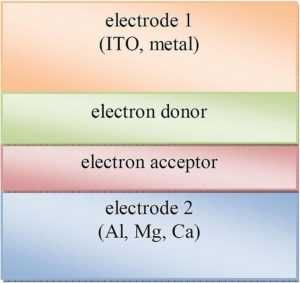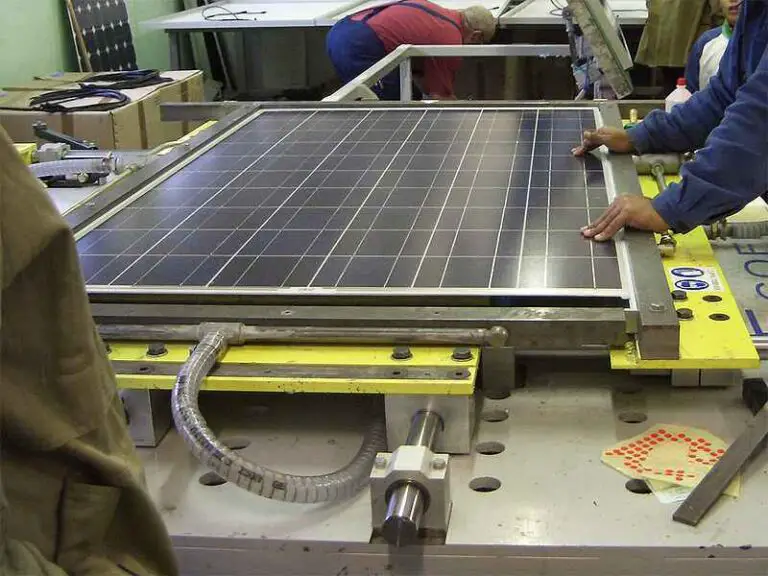7 Types of Organic Solar Cells and Their Characteristics Explained
Types of organic solar cells are; tandem, dye-sensitized, bulk heterojunction, single-layer, multilayer, molecular and polymeric solar cells.
This article discusses the types of organic solar cells and their characteristics, as outlined below;
-Types of Organic Solar Cells based on Working Principle
-Types of Organic Solar Cells based on Configuration
-Types of Organic Solar Cells based on Chemical Complexity
-Types of Organic Solar Cells based on Working Principle
1). Organic Tandem Solar Cell (as one of the Types of Organic Solar Cells)
Organic tandem solar cells (or ‘Tandem Organic Photovoltaic’ (TOPV) cells) are composite solar units made by combining multiple sub-cells.
As a result of their structural and compositional configuration, TOPVs are among the most efficient types of organic solar cells.
The goal of producing tandem organic solar cells is to multiply or maximize organic solar cell efficiency [1]. Efficiency here refers to energy efficiency, which is proportional to the effectiveness with which the solar cell absorbs and converts solar energy to electricity.
Combination of sub-cells may also be called ‘stacking’ [6]. Organic solar cell materials and architecture may vary from one tandem cell to another, depending on available raw materials, technology, and required results. These differences lead to slight differences in the performance of the cell.
However, organic tandem solar cells are built for energy conservation and ecosystem-compatibility. They are an ideal renewable energy initiative for sustainable development and circular economy.
The levels of technological maturity and adoption of TOPV technology are currently low, and likely to increase alongside other sustainable energy technologies like smart grids, renewable turbines and energy management systems.
2). Dye-Sensitized Solar Cell (DSSCs)
The dye-sensitized solar cell (DSSC) is a type of solar cell in which the primary photovoltaic component is organic dye.
Utilization of organic dye in solar technology is a relatively-recent development, and partly derives from studies of natural bioenergy recycling across the trophic levels of the energy pyramid.
Organic dyes are similar to chlorophyll pigments with which plants absorb and convert solar energy in the process of photosynthesis.
The mechanism used to generate electricity in dye-sensitized solar cells is an electrochemical mechanism [10], and differs slightly from the conventional photoelectric principle of solar technology.
Rather, it is more similar to the electrochemical transmission mechanism of hydrogen fuel cells and deep cycle batteries, which depend on chemical reactions for electricity generation.
Advantages of dye-sensitized solar cells include; low cost, low environmental degradation risk, and technical flexibility.
For structural stability, the dye is usually held by a porous layer composed of nanoparticles.
Examples of dyes used in such solar cells include; carbol fuchsin, eosin Y, crystal violet, methyl orange, fast green and aniline blue [3].

3). Organic Bulk Heterojunction (BHT) Cell (as one of the Types of Organic Solar Cells)
Organic bulk heterojunction solar cells are among the most common and efficient types of organic solar cells.
The principle behind BHT cells is similar to that which is behind tandem organic solar cells. It is concerned with the increase of efficiency and performance by combining multiple sub-cells.
However, while tandem cells focus on maximizing absorption capacity, bulk heterojunction cells are focused on combining the electrical properties of different materials to form a hybrid photovoltaic unit. This enables the solar cell to exhibit the beneficial characteristics of each of these materials simultaneously.
The performance of a bulk heterojunction solar cell depends on structural configuration, chemical composition of sub-cells, and overall layer morphology [9].
-Types of Organic Solar Cells based on Configuration
4). Single-layer Organic Solar Cell
Single-layer solar cell is the most basic type or organic solar cell, in terms of configuration, structure and architecture.
It is called ‘single-layer’ because it uses a single layer of photoelectric material to generate electricity. This single layer transmits the electricity that it generates, to electrodes (cathode, anode) in-between which it is sandwiched.
Single-layer solar cells have numerous advantages, including ease of construction, simple structure, high photon transmission, and high performance. As a result, they are considered to be a potential sustainable replacement for silicon solar cells [5].
Solar panels comprising of single-layer organic PV cells have recorded efficiencies of more than 16% [7].

5). Multilayer Organic Solar Cell (as one of the Types of Organic Solar Cells)
Multilayer organic solar cell is a broad category that encompasses other types of organic solar cells like bulk heterojunction and tandem cells.
The principle behind multilayer solar cells is to combine the capacities and benefits of multiple solar units, in order to produce one composite, high-capacity solar cell. Usually, two layers are sandwiched between the electrodes, with one serving as an electron donor and the other as an acceptor.
Multilayer cells have the disadvantage of being more complex than single-layer cells. However, they also have the advantage of being highly effective.
Because of their high capacity, conversion efficiency and multiplied absorption, multilayer solar cells are an economical and eco-friendly option, that suits the demands for sustainability of power generation [8].
Multilayer solar cells are also very versatile compared to single-layer cells. This is because of their multi-characteristic nature.
It is important to note that not all multilayer solar cells are made using several different photovoltaic materials. Rather, the name ‘multilayer’ is derived from the presence of more than one sub-cell in the photovoltaic layer.

Types of Organic Solar Cells: Multilayer Solar Cell (Credit: S.Babar 2009 .CC BY-SA 3.0.)
-Types of Organic Solar Cells based on Chemical Complexity
6). Molecular Organic Solar Cell
Also known as ‘all-small-molecule organic solar cells (OSCs)’, molecular organic solar cells are those in which the photovoltaic unit is composed on non-polymeric chemical components.
The advantages of this type include ease of biodegradation on disposal, stability of electricity generation, and high reliability.
Because the photovoltaic unit comprises of independent molecules and compounds (not bound to one another as in polymeric solar cells), each chemical component can convert solar energy effectively without being affected by other components.
As part of efforts to improve performance, some innovative configurations of molecules in these solar cells have been found to boost efficiency to more than 15.3% [2]. This is a high value, considering that the average organic solar cell efficiency is 11%.
The chemical structure of molecular organic solar cells may include elements like Fluorine and Chlorine, and aromatic organic compounds like phenyls.
7). Polymeric Organic Solar Cell (as one of the Types of Organic Solar Cells)
Polymeric organic solar cell is alternatively referred to as ‘all-polymer solar cell.
It is more common than molecular solar cells, so that many other types of organic solar cells can be placed within the polymeric category.
As the name implies, polymeric organic solar cells have photovoltaic materials that are composed of polymeric compounds.
These cells may have various structural configurations, including single-layer and multilayer. In multilayer variant, the photovoltaic unit may comprise of sub-cells made from different polymers with distinctive photoelectric characteristics.
The main advantage of polymeric organic solar cells is homogeneity of the photovoltaic component. However, multilayer cells of this type can achieve efficiencies of up to 15.8% [4].
Conclusion
Types of organic solar cells are;
1. Organic Tandem Solar Cells
2. Dye-Sensitized Solar Cell (DSSC)
3. Organic Bulk Heterojunction (BHT) Cell
4. Single-layer Organic Solar Cell
5. Multilayer Organic Solar Cell
6. Molecular Organic Solar Cell
7. Polymeric Organic Solar Cell
They are classified based on working principle, configuration, and chemical complexity.
References
1). Ameri, T.; Dennler, G.; Lungenschmied, C.; Brabec, C. J. (2009). “Organic tandem solar cells: A review.” Energy & Environmental Science 2(4):347-363. Available at: https://doi.org/10.1039/b817952b. (Accessed 14 September 2022).
2). Dingqin, H.; Qianguang, Y.; Zheng, Y.; Tang, H.; Chung, S.; Singh, R.; Lv, J.; Fu, J.; Kan, Z.; Qin, B.; Chen, Q.; Liao, Z.; Chen, H.; Xiao, Z.; Sun, K.; Lu, S. (2021). “15.3% Efficiency All‐Small‐Molecule Organic Solar Cells Achieved by a Locally Asymmetric F, Cl Disubstitution Strategy.” Advanced Science 8(8). Available at: https://doi.org/10.1002/advs.202004262. (Accessed 14 September 2022).
3). El-Agez, T. M.; Elrefi, K. S.; Abdel-latif, M. (2014). “Dye-sensitized solar cells using some organic dyes as photosensitizers.” Optica Applicata 44(2):345-351. Available at: https://doi.org/10.5277/oa140215. (Accessed 14 September 2022).
4). Fu, H.; Yuxiang, L.; Yu, J.; Wu, Z.; Fan, Q.; Lin, F.; Woo, H. Y.; Gao, F.; Zhu, Z.; Jen, A. K. (2021). “High Efficiency (15.8%) All-Polymer Solar Cells Enabled by a Regioregular Narrow Bandgap Polymer Acceptor.” Journal of the American Chemical Society 143(7). Available at: https://doi.org/10.1021/jacs.0c12527. (Accessed 14 September 2022).
5). Kesinro, O. R.; Boyo, A. O.; Akinyemi, M. L.; Emetere, M. E.; Aizebeokhai, A. P. (2021). “Progress on Organic Solar Cells: A Short Review.” IOP Conference Series Earth and Environmental Science 665(1):012036. Available at: https://doi.org/10.1088/1755-1315/665/1/012036. (Accessed 14 September 2022).
6). Mathews, I.; O ‘ Mahony, D.; Yu, W.; Gordan, D.; Cordero, N.; Corbett, B.; Morrison, A. P. (2011). “Mechanically Stacked Solar Cells for Concentrator Photovoltaics.” International Conference on Renewable Energy and Power Quality 2011, Gran Canaria, Spain. Available at: https://www.researchgate.net/publication/260796969_Mechanically_Stacked_Solar_Cells_for_Concentrator_Photovoltaics. (Accessed 14 September 2022).
7). Ming, Z.; Zhu, L.; Guanging, Z.; Hao, T.; Oiu, C.; Hu, Q.; Larson, B.; Feng, W.; Ma, Z.; Tang, Z.; Zhu, H.; Zhang, Y.; Russell, T.; Liu, F. (2020). “Single-layered organic photovoltaics with double cascading charge transport pathways: 18 % efficiencies.” Available at: https://doi.org/10.21203/rs.3.rs-44585/v1. (Accessed 14 September 2022).
8). Najam, S.; Dubev, C.; Kumar, B. (2019). “Behaviour Analysis of Multilayer and Bulk Heterojunction Organic Solar Cell With Aluminium-Doped Zinc Oxide Anode Layer.” 2019 International Conference on Electrical, Electronics and Computer Engineering (UPCON). Available at: https://doi.org/10.1109/UPCON47278.2019.8980282. (Accessed 14 September 2022).
9). Vandewal, K.; Himmelberger, S.; Salleo, A. (2013). “Structural Factors That Affect the Performance of Organic Bulk Heterojunction Solar Cells.” Macromolecules 46(16):6379-6387. Available at: https://doi.org/10.1021/ma400924b. (Accessed 14 September 2022).
10). Wei, D. (2010). “Dye Sensitized Solar Cells.” International Journal of Molecular Sciences 11(3):1103-13. Available at: https://doi.org/10.3390/ijms11031103. (Accessed 14 September 2022).

